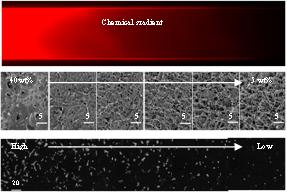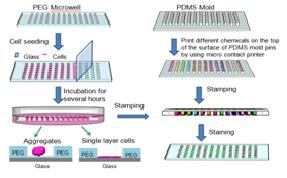Biomaterials
Biomaterials is the broad research area in our lab and efforts lie at the interface of tissue engineering, microfluidics and stem cell bioengineering. This includes synthesis and characterization of new biomaterials, use of photocrosslinkable biomaterials for patterning the surfaces, understanding cell-biomaterials interaction using high throughput screening and development of micro-/nanoparticles for controlled release. Currently, we have synthesized sugar-based photocrosslinkable synthetic and natural polymers for tissue engineering application. These polymers are being characterized for their mechanical properties, cytotoxicity and ability to pattern them into various shapes and sizes. Natural and synthetic materials used in the lab include alginate, hyaluronic acid, collagen, polycaprolactone, polyglycerol sebacate for scaffold-based tissue engineering.

Another area of interest in the lab is generation of chemical and material gradients in the hydrogels. For instance, cells require various biochemical signals interspersed inside the substrate spatially and temporally for attachment, growth and proliferation. It is laborious to screen various chemicals in a different concentration ranges individually. However, formation of chemical and materials gradients is valuable to investigate the cell-material interaction in a simple and high throughput manner and can be used in designing gradients of biomimetic materials for tissue engineering applications. To demonstrate potential applications of this approach, gradient of cell adhesion ligands (RGD) was generated in PEG-based hydrogels. The cells attached along the hydrogel materials in a manner consistent with the RGD gradient as shown in the figure.

Researchers are also involved in developing 3D high throughput platform for ECM-cell interaction as well as drug screening. This approach is based on using microfabricated PEG microwells for cell-seeding. These microwells can be further used for screening effect of drugs in 2D or 3D cell culture as depicted.
We are also using microarray technologies to investigate in a high throughput manner the effects of ECM components and combinations of those components on 2D cultures.
Our lab is also focused on directed self-assembly of PEG-hydrogels for tissue engineering applications. This bottom-up approach is based on using either hydrophobic-hydrophillic forces to direct self-assembly of hydrogel microunits or use selective surface functionalization of hydrogels that could allow tight control over the assembly of microunits.
